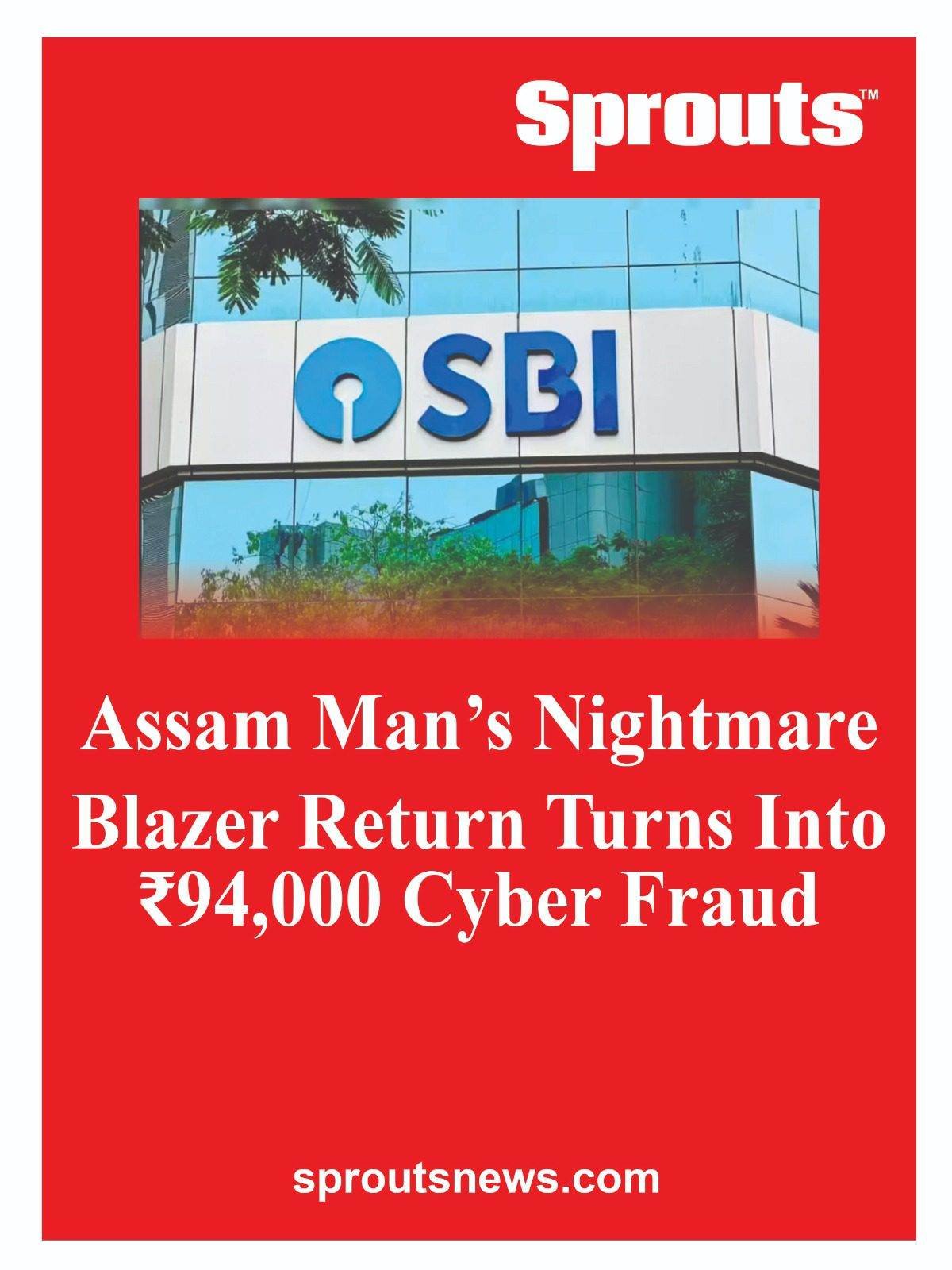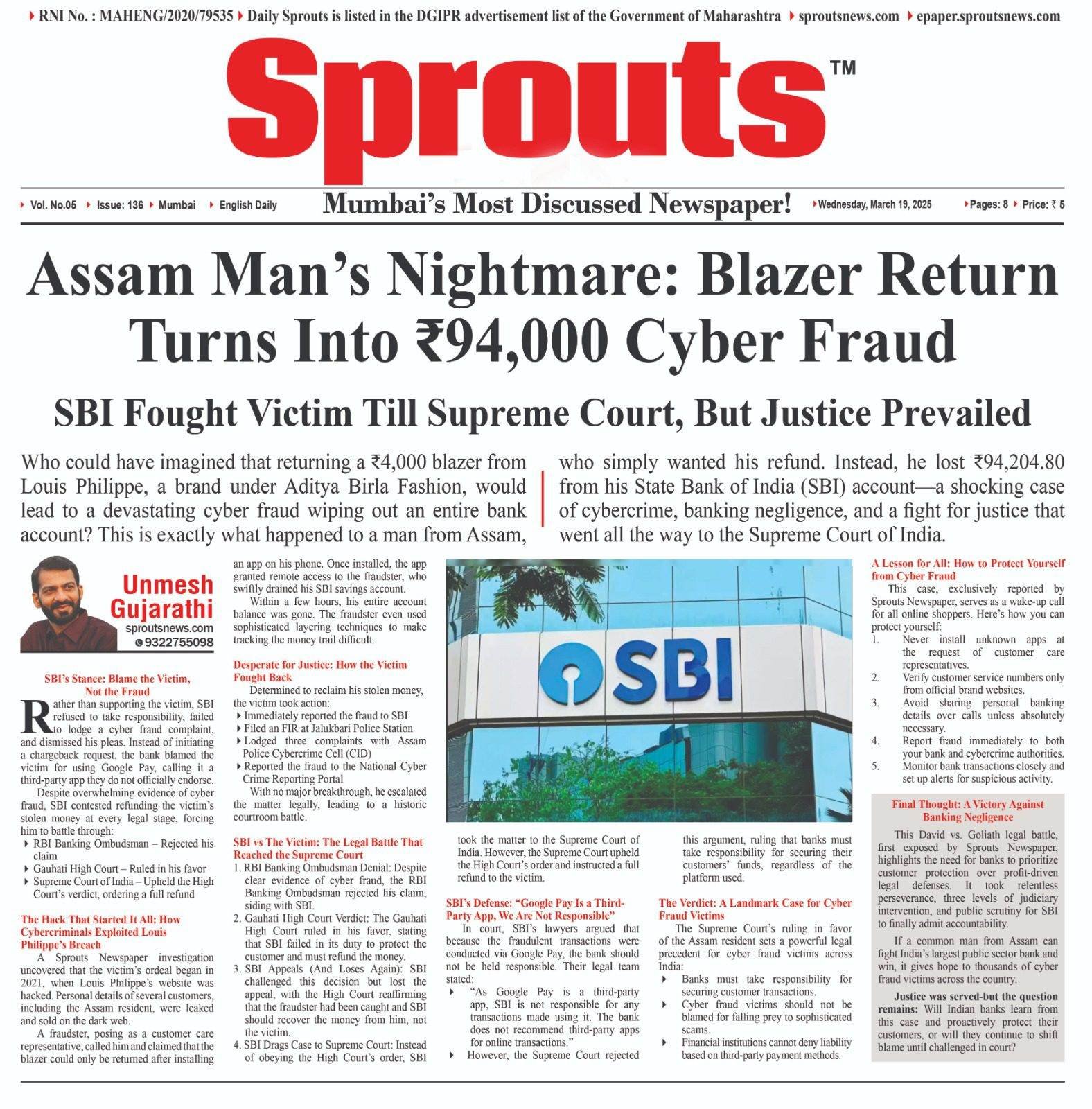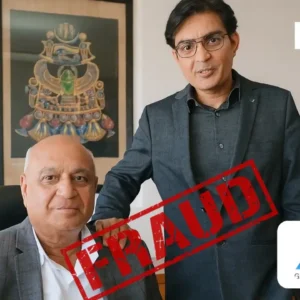
- SBI Fought Victim Till Supreme Court, But Justice Prevailed
- • SBI’s Stance: Blame the Victim, Not the Fraud
- Also Read: Legal Ethics Restored: Sprouts News’ Fight Against Law Firm Commercialization Pays Off
- • Desperate for Justice: How the Victim Fought Back
- • SBI’s Defense: “Google Pay Is a Third-Party App, We Are Not Responsible”
- • A Lesson for All: How to Protect Yourself from Cyber Fraud
- • Final Thought: A Victory Against Banking Negligence
- Justice was served—but the question remains:
SBI Fought Victim Till Supreme Court, But Justice Prevailed
Unmesh Gujarathi
Sprouts News Excludive
Who could have imagined that returning a ₹4,000 blazer from Louis Philippe, a brand under Aditya Birla Fashion, would lead to a devastating cyber fraud wiping out an entire bank account? This is exactly what happened to a man from Assam, who simply wanted his refund. Instead, he lost ₹94,204.80 from his State Bank of India (SBI) account—a shocking case of cybercrime, banking negligence, and a fight for justice that went all the way to the Supreme Court of India.
• SBI’s Stance: Blame the Victim, Not the Fraud
Rather than supporting the victim, SBI refused to take responsibility, failed to lodge a cyber fraud complaint, and dismissed his pleas. Instead of initiating a chargeback request, the bank blamed the victim for using Google Pay, calling it a third-party app they do not officially endorse.
Despite overwhelming evidence of cyber fraud, SBI contested refunding the victim’s stolen money at every legal stage, forcing him to battle through:
– RBI Banking Ombudsman – Rejected his claim
– Gauhati High Court – Ruled in his favor
– Supreme Court of India – Upheld the High Court’s verdict, ordering a full refund
• The Hack That Started It All: How Cybercriminals Exploited Louis Philippe’s Breach
A Sprouts Newspaper investigation uncovered that the victim’s ordeal began in 2021, when Louis Philippe’s website was hacked. Personal details of several customers, including the Assam resident, were leaked and sold on the dark web.
A fraudster, posing as a customer care representative, called him and claimed that the blazer could only be returned after installing an app on his phone. Once installed, the app granted remote access to the fraudster, who swiftly drained his SBI savings account.
Within a few hours, his entire account balance was gone. The fraudster even used sophisticated layering techniques to make tracking the money trail difficult.
Also Read: Legal Ethics Restored: Sprouts News’ Fight Against Law Firm Commercialization Pays Off
• Desperate for Justice: How the Victim Fought Back
Determined to reclaim his stolen money, the victim took action:
– Immediately reported the fraud to SBI
– Filed an FIR at Jalukbari Police Station
– Lodged three complaints with Assam Police Cybercrime Cell (CID)
– Reported the fraud to the National Cyber Crime Reporting Portal
With no major breakthrough, he escalated the matter legally, leading to a historic courtroom battle.
• SBI vs The Victim: The Legal Battle That Reached the Supreme Court
1. RBI Banking Ombudsman Denial: Despite clear evidence of cyber fraud, the RBI Banking Ombudsman rejected his claim, siding with SBI.
2. Gauhati High Court Verdict: The Gauhati High Court ruled in his favor, stating that SBI failed in its duty to protect the customer and must refund the money.
3. SBI Appeals (And Loses Again): SBI challenged this decision but lost the appeal, with the High Court reaffirming that the fraudster had been caught and SBI should recover the money from him, not the victim.
4. SBI Drags Case to Supreme Court: Instead of obeying the High Court’s order, SBI took the matter to the Supreme Court of India. However, the Supreme Court upheld the High Court’s order and instructed a full refund to the victim.
• SBI’s Defense: “Google Pay Is a Third-Party App, We Are Not Responsible”
In court, SBI’s lawyers argued that because the fraudulent transactions were conducted via Google Pay, the bank should not be held responsible. Their legal team stated:
> “As Google Pay is a third-party app, SBI is not responsible for any transactions made using it. The bank does not recommend third-party apps for online transactions.”
However, the Supreme Court rejected this argument, ruling that banks must take responsibility for securing their customers’ funds, regardless of the platform used.
• The Verdict: A Landmark Case for Cyber Fraud Victims
The Supreme Court’s ruling in favor of the Assam resident sets a powerful legal precedent for cyber fraud victims across India:
– Banks must take responsibility for securing customer transactions.
– Cyber fraud victims should not be blamed for falling prey to sophisticated scams.
– Financial institutions cannot deny liability based on third-party payment methods.
• A Lesson for All: How to Protect Yourself from Cyber Fraud
This case, exclusively reported by Sprouts Newspaper, serves as a wake-up call for all online shoppers. Here’s how you can protect yourself:
1. Never install unknown apps at the request of customer care representatives.
2. Verify customer service numbers only from official brand websites.
3. Avoid sharing personal banking details over calls unless absolutely necessary.
4. Report fraud immediately to both your bank and cybercrime authorities.
5. Monitor bank transactions closely and set up alerts for suspicious activity.
• Final Thought: A Victory Against Banking Negligence
This David vs. Goliath legal battle, first exposed by Sprouts Newspaper, highlights the need for banks to prioritize customer protection over profit-driven legal defenses. It took relentless perseverance, three levels of judiciary intervention, and public scrutiny for SBI to finally admit accountability.
If a common man from Assam can fight India’s largest public sector bank and win, it gives hope to thousands of cyber fraud victims across the country.
Justice was served—but the question remains:
Will Indian banks learn from this case and proactively protect their customers, or will they continue to shift blame until challenged in court?
















